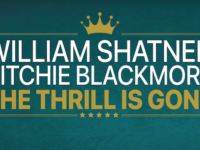By 1974, Deep Purple had been together for several years and were one of the hottest bands in the world. But founding member, guitarist Ritchie Blackmore, was not a happy camper.
Personnel changes, combined with a move in a different musical direction, did not coincide with the vision of the flashy fretmaster. So Ritchie duly departed the revered British band and formed his own group called Ritchie Blackmore’s Rainbow that included lead singer Ronnie James Dio, bassist Craig Gruber, keyboardist Micky Lee Soule, and drummer Gary Driscoll.
The band’s debut album, Ritchie Blackmore’s Rainbow (released in August 1975 by Polydor Records) may not have quite met the lofty expectations of the six-string god’s rabid fans and nitpicking critics, but still presented a plethora of cool and interesting moments. The disc also introduced the mighty and majestic pipes of Ronnie James Dio – who had been sharpening his craft in various acts for well over a decade and cut a trio of albums with Elf – to a much larger audience.
Ritchie Blackmore’s Rainbow can further be cited as inventors of medieval metal, if there is such a genre. Moody and mystical, the band’s lyrics often leaked impressions of wizards, magicians, and kings, while occasional baroque flourishes rose to the surface.
Fired by bold and intimidating vocals, “Man on the Silver Mountain” is a bruising rocker and “Black Sheep of the Family,” which was originally done by Quatermass, rattles and prattles to a bluesy groove, highlighted by killer slide guitar work. Other tracks capturing the band squarely in the zone on Ritchie Blackmore’s Rainbow are “Sixteenth Century Greensleeves,” the keen and progressive “Self Portrait,” and “Catch A Rainbow” that gushes and glows with spellbinding beauty.
The Yardbirds are acknowledged on a jumpy instrumental version of “Still I’m Sad” that hurls a cowbell into the jam for good measure, and the chunky boogie rhythms of “If You Don’t Like Rock And Roll” sounds sort of like a quirky blend of Foghat and Blue Oyster Cult. Ritchie’s axe-grinding on Ritchie Blackmore’s Rainbow tended to be a bit tame compared to a lot of the far-out stuff he played in Deep Purple, but the color and intensity remained firmly intact.
Add Ronnie James Dio’s powerhouse lungs to the show, along with the tight and energetic performances of the band, and Ritchie Blackmore’s Rainbow stands as an excellent hard rock statement blazing with innovative arrangements and ripped and regal melodies.
Ritchie Blackmore’s Rainbow soon shaved their name down to simply Rainbow, and would constantly encounter a revolving door of musicians. The band eventually embraced a poppier tone and obtained a healthy degree of commercial success. Ronnie James Dio became Black Sabbath’s front man when Ozzy Osbourne left the band, and embarked on a solo career in the early 80s that turned him into a certified heavy metal icon.
- Why Aerosmith Finally Broke Through With ‘Get Your Wings’ - March 5, 2024
- How ‘The Birds, the Bees and the Monkees’ Blew Away Their Pre-Fab Image - April 10, 2023
- Steve Howe Made a Colorful, Quite Surprising Debut With Tomorrow - February 20, 2023




